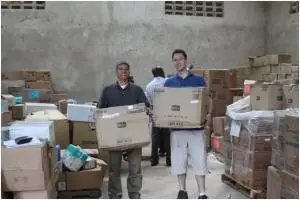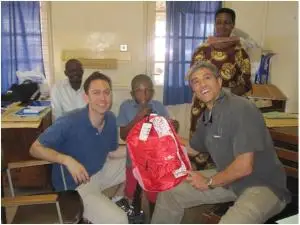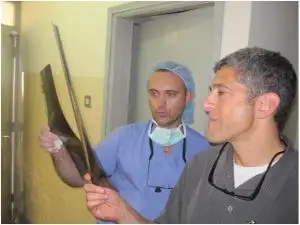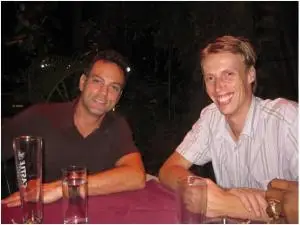Day 3- August 16th
The morning began with a trip to the warehouse where tens of thousands of dollars of medical supplies were waiting for us. VeAhavta, a humanitarian organization based out of Toronto, organized and delivered a 40-foot container also containing 200 Kinder Kits, bags of school supplies for our spine patients and children in the village of Putti. We divided up the supplies: two-thirds would go to the state-run impoverished Mulago hospital and the rest to the Case Hospital for future use by the team and charitable use by the Case medical staff. For all those at VeAhavta we once again thank you for the tremendous effort.
Jordan, Dr. Lieberman and the medical supplies and Kinder Kits donated by VeAhavta.

Amy, Jordan and Dr. Lieberman returned to the penalty box to review the x-rays and CTs of yesterday’s patients. Each study was as unique and special as the children themselves. They were tremendous deformities but nothing too intimidating for Dr. Lieberman. Dr L then painstakingly described the expectations and implications of major surgery to these young patients overcoming the language and cultural barriers. It was imperative that both parties be in favour of the decision. Ultimately surgery was planned for five of the children. For the rest we prescribed exercise and annual follow-up, hoping the deformities will not progress to the point that precludes future surgery. Fortunately, everyone left with a wide-eyed grin sporting their new red backpacks with notebooks, pens, and pencils for school. MedWish, an organization based out of Cleveland, who have been wonderful partners for many years now, also donated vitamins and toothbrushes, which will go a long way towards our patients’ general health.

Dr. Ilalov, Dr. Kayanja, and anesthesiologists Kristoff and Zbigniew were kept busy in the O.R at Mulago. Their patient was a 63 year-old educated man who, 6 weeks earlier, summer-saulted forward off of his boda-boda (motorcycle) while riding along the country-side. Motorcycle accidents are the commonest cause of spinal cord injury here in Uganda. Two hours after his flip, he was discovered by a lady in the field who found him paralyzed below his shoulders, with his head sunken into his chest. On his instruction, she grabbed his ears and lifted his head back into place then called for help. Kids, do not try this at home! As if this trauma wasn’t enough, he was picked up placed on the back of another boda-boda and “bobbled” along for 2 hours down the cratered roads, with an unstable neck, already paralyzed, to the nearest hospital. It turned out he had dislocated the joint connecting two vertebrae in his neck (a bilateral jumped facet, in medical terminology) and the lady in the field actually “reduced” it to its original position. There was also a small vertebral fracture above the dislocation and damage to the spinal cord lining (a dural tear). Surgery to stabilize his spine and reduce further damage took seven hours. After the surgery it was clearly evident that he would have trouble breathing. Zbigniew, who has a special interest in mechanical ventilation, brought with him a CPAP machine (continuous positive airway pressure breathing device) and applied it to the patient (think of the mechanism as an air hose continuously inflating a tire at the same rate it is losing air through a puncture). We all have no doubt that Zbigniew’s efforts spared this individual further suffering and maybe even saved his life.
At Case, Dr. St. Clair and Dr. Siemionow operated on F.M, a 22 year-old male finance student. In 2005 he’d had surgery for congenital scoliosis which at the time he was told would be free of charge. After the surgery, he learned that a different doctor had operated on him and that he owed the equivalent of 2000 USD. His surgery today was a revision procedure, as the poorly-placed instrumentation from 2005 was no longer effective. He was also concerned about returning to his studies but we reassured him that his recovery would take 4-6 weeks. The surgery took 6 hours, which coincided perfectly with the passionfruit-flavoured “6-hour-power” juice that Dr. Siemionow consumed beforehand. F.M. asked many questions about the prevalence of scoliosis in Uganda. In more developed nations, pediatricians and elementary schools screen for abnormal spine growth annually from a young age. When it does occur, measures are taken to prevent extensive curvature. Unfortunately Uganda’s population seems to have missed out on the epidemiology lecture and the incidence is disproportionately high. Even with screening the burden of spinal deformity in Uganda is substantial.
Dr. Lieberman and Dr. Ilalov discuss the X-ray and potential to operate on a 20-year old man who fell 70 feet into an empty toilet well under construction. The man waited 4 days until he was discovered. He suffered several broken and dislocated vertebrae.

For dinner tonight we went to the all-time favourite Khyber Pass Indian Curry House. The discussion over the flavourful curry dishes was dominated by Arnie, a free-lance reporter from Norway who was interested in learning more about the spine and Torah missions.
Our (now) cleanly shaven equipment manager Brian Failla and Norwegian journalist Arnie at Khyber Pass.

Quote of the day:
“I wouldn’t have made it through surgery today without that 6 hours of pure PASSION!” – Dr. Kris S, with reference to the energy drink.
Some of our patients and their family members with their Kinder Kits!



